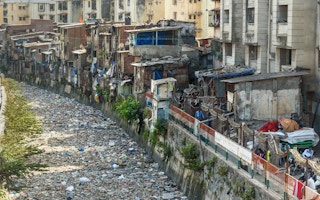Samita Chavan used to wake up at 3am every day to the sound of her neighbour’s wet grinder in Mumbai’s Dharavi slum. Now, she is adjusting to a rare silence after three months of lockdown that saw tens of thousands of migrant workers leave the city.
Dharavi, believed to be Asia’s largest slum, has been hailed as a success story in the battle against the coronavirus pandemic, bringing cases from a daily average of 100 in April to about 10 in July, say city officials, thanks to a strict lockdown.
But cash-starved slum dwellers and informal traders fear a long-term hit to their income, as about 150,000 migrant workers have left Dharavi - according to official estimates - and small businesses face permanent closure.
“Many factories have exhausted their capital and there is still no idea when things will start improving … the small factories of Dharavi do not have the capacity to suffer this scale of loss,” said Babu Khan, president of the Dharavi Garment Association.
“These factories can’t afford to stop work even for a week. It has been about four months now. About 80 per cent of the factories here are still shut,” he told the Thomson Reuters Foundation.
Particularly at risk are informal traders - which according to Khan make up 70 per cent of businesses in Dharavi - as they are not eligible for bank loans or government schemes to boost lockdown-hit industries.
Business owner Rais, 60, who makes brass belt buckles, said that “silence means everything is shut. I have closed my business for good … I could not sustain it.”
“I don’t know what I will do next… I have never seen Dharavi like this before,” said Rais, who goes by one name.
“
Many factories have exhausted their capital and there is still no idea when things will start improving … the small factories of Dharavi do not have the capacity to suffer this scale of loss.
Babu Khan, president, Dharavi Garment Association
Disease tracking
Health experts had warned it would be “impossible” to stop the fast-spreading virus in slums where social distancing is difficult due to cramped housing and poor sanitation.
“The silence during the lockdown was of fear. I would see dead bodies every day and we were panicking watching the news,” said care worker Chavan, 54, who has spent her entire life in Dharavi. “We had gone numb.”
But authorities used drones, re-oriented traffic cameras, and heat maps to help enforce a lockdown in what is one of the most densely populated areas on earth, and led an aggressive tracing and testing campaign.
Chavan said her neighbour had contracted the virus and was moved into a school repurposed as a quarantine facility. “She recovered and returned home,” Chavan said.
In addition to daily screening and isolation centres, Khan said the enlisting of Dharavi’s private clinics for testing allowed for early diagnosis and treatment, ensuring fewer people needed beds.
A migrant exodus also led to less crowding at community toilets and more empty rooms for its residents, who predominantly live in one-room tenements with six to 10 members of their families or co-workers, said officials.
“It (the exodus) partly aided in checking the spread of the virus. The screening load also reduced (on health workers),” said Kiran Dighavkar, an assistant municipal commissioner overseeing measures to contain the coronavirus in the area.
Silence
The sound of vehicles, the clank of metals and the hum of hundreds of sewing machines in workshops and of Bollywood songs playing on the radio typically form the background score of Dharavi life.
The buzz reflects the slum’s thriving informal economy, with industrious residents recycling scrap, making earthen lamps, and packing snacks to feed rushed commuters.
Before the pandemic noise levels were consistently between 85 to 105 decibels - the equivalent of car horns or a music concert - according to anti-noise pollution campaigner Sumaira Abdulali, who has recorded the slum’s sound levels for years.
“People have lived with this industrial noise all along. This is the first time they are experiencing quiet,” she said.
As Dharavi started easing lockdown restrictions last month, daily life has fundamentally changed, say residents.
“It is a different quiet now. This area used to buzz from early morning,” said Chavan.
“My neighbour had his idlis (steamed rice cakes) and wadas (fritters) ready by 5am. Now, even at 7am I don’t feel it is morning yet,” she said.
Reopening
Factories in Dharavi are posting messages on social media and phoning workers to ask them to return, promising to cover their food and accommodation, said Khan of the garment association.
But as some migrant workers begin to return, officials like Dighavkar brace for the challenges ahead.
“People are keen to reopen their factories, keen to resume work and are interacting with each other,” he said. “Few factories have started reopening and some labourers are returning.”
“We have to ensure the habits of distancing and sanitisation continue … and that is our next challenge. This is a dynamic disease,” he added.
Slum dwellers, in the meantime, are ready for the silence to end.
Farhana Sarfaraz Sheikh, 29, who migrated to Mumbai 15 years ago and found accommodation, training and a computer operator job in Dharavi, said noise meant there was work going on.
“It shouldn’t be this quiet. Life has to begin,” she said.
This story was published with permission from Thomson Reuters Foundation, the charitable arm of Thomson Reuters, that covers humanitarian news, climate change, resilience, women’s rights, trafficking and property rights. Visit http://news.trust.org/climate.














